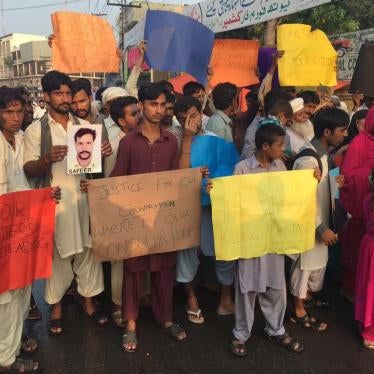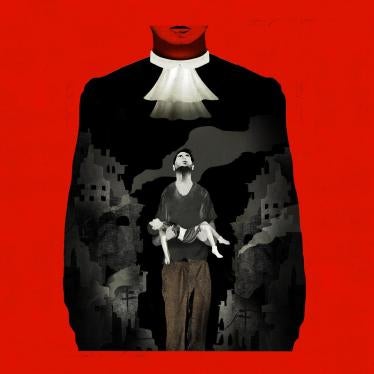(Misrata, Libya) – The National Transitional Council (NTC) in Libya should promptly open an independent and impartial investigation with international participation into the deaths of the former leader Muammar Gaddafi and his son Muatassim Gaddafi, Human Rights Watch said today.
The NTC and other sources reported the deaths of both men in Sirte on October 20, 2011. It is unclear whether the men died from wounds received in combat or were killed in custody. However, information obtained by Human Rights Watch, as well as videos and photographs apparently taken that day showing both men alive in the custody of anti-Gaddafi forces, indicate that they might have been executed after being detained.
“There is ample evidence to open a credible investigation into the deaths of Gaddafi and his son Muatassim,” said Sarah Leah Whitson, Middle East and North Africa director at Human Rights Watch. “Finding out how they died matters. It will set the tone for whether the new Libya will be ruled by law or by summary violence.”
The willful killing of a person in custody is a serious violation of the laws of war and is a war crime that could be prosecuted by the International Criminal Court, Human Rights Watch said. The laws of war also oblige parties to a conflict to provide medical care to captured combatants.
A failure by the NTC to investigate these deaths promptly and impartially, along with the many alleged war crimes by Gaddafi forces, would send a dangerous message that Libyans can take justice into their own hands, Human Rights Watch said.
The unexplained circumstances of Muammar Gaddafi’s death must be investigated, Human Rights Watch said. The earliest known video of Gaddafi in detention, reportedly taken moments after his capture, shows him alive but bleeding from the left side of the face. Anti-Gaddafi fighters are seen leading him away upright from the place in Sirte where he was captured. On the soundtrack are heard shouts of, "Don’t kill him! Don't kill him! We need him alive!"
Amateur video apparently taken later shows fighters putting Gaddafi on the hood of a vehicle, where he wipes blood from his face. Another video shows him getting pulled from the vehicle into an angry mob that appears to beat him.
Human Rights Watch briefly viewed Muammar Gaddafi’s body on October 21 in a refrigerated meat locker in the town of Misrata, while hundreds of residents lined up outside to see the corpse of the former leader. Those guarding the body did not allow a Human Rights Watch researcher to turn the body over or to conduct a close inspection. A bullet entry was visible on Gaddafi’s left temple. No exit wound was visible on the other side. Two gashes, each about one inch long, were visible on his central torso. Human Rights Watch could not determine the cause of his death.
Video footage and photographs of Muatassim Gaddafi, previously Libya’s national security chief and commander of Gaddafi’s forces in central and eastern Libya, strongly suggest he was killed after being detained, Human Rights Watch said. In one brief video posted on Facebook, he is seen in apparent custody in blood-soaked clothes smoking a cigarette in a room. No wounds are visible on his neck or face. A photograph viewed by Human Rights Watch also shows him in that room drinking a bottle of water. Another video shows him lying alive in the same room, perhaps with a wound on his neck. Later images of his body clearly show a deep wound on the front of his neck.
Human Rights Watch briefly viewed the front of Muatassim Gaddafi’s body on October 20 in Misrata and saw the substantial wound on his throat. It was unclear whether that wound caused his death.
A commander from the Sahel al-Sharki Brigade from Misrata, which was directly involved in the fighting that resulted in Gaddafi’s capture in Sirte, told Human Rights Watch that on October 20, the brigade was involved in a fierce firefight beginning at about 8:30 a.m., when a convoy of about 50 vehicles tried to speed out of Sirte to the west. Around 9:30 a.m., NATO warplanes hit the convoy, he said. The fighting continued for about another hour.
Around 11 a.m., fighters from other brigades swept the area, where they found Muammar Gaddafi in a drain pipe under a road. He was wounded, but apparently not seriously, the commander told Human Rights Watch.
The commander said that at that point the situation “got out of control.” Fighters were pulling and punching Gaddafi, and they tried to drive a car with him on the hood. Gaddafi fell off at one point, sustaining further injuries. Gaddafi did not have any bullet wounds to the head at that time, the commander told Human Rights Watch.
Human Rights Watch visited the location where Gaddafi was captured. About 95 bodies lay amid the wreckage of dozens of cars. Most of the people seemed to have been killed in the NATO airstrike or in the fighting between Gaddafi loyalists and NTC forces. About 30 bodies were carbonized because vehicles’ fuel tanks had exploded.
At the scene, Human Rights Watch saw the bodies of six to ten Gaddafi fighters, including some with bandages. These fighters appear to have been executed. Their bodies were lying on the ground with bullet wounds to their heads and impact marks from the bullets in the ground.
Leaders of the NTC have given varying accounts of Muammar Gaddafi’s death, including that he was killed “in crossfire” between pro-Gaddafi and NTC forces.
None of the witnesses in Sirte interviewed by Human Rights Watch mentioned a gun battle after Gaddafi’s capture, however.
Human Rights Watch repeated its concern that all pro-Gaddafi fighters captured in Sirte should not be mistreated. The exact number of captured fighters and their location remains unknown.
“Fighters taken into custody should be sent immediately to recognized places of detention and treated humanely.” Whitson said. “Those on all sides implicated in serious crimes should be fairly prosecuted.”
Two senior Gaddafi officials wanted by the International Criminal Court remain unaccounted for: Gaddafi’s son Seif al-Islam Gaddafi and Libya’s former intelligence chief Abdullah Sanussi. Both men, when captured, should be transferred to the International Criminal Court, Human Rights Watch said.






